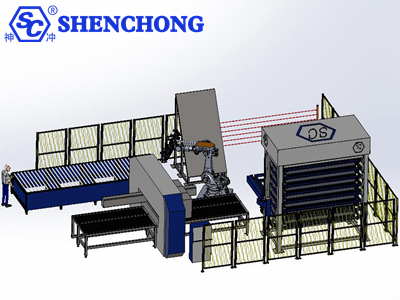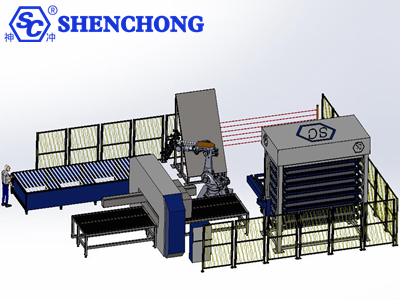
The sheet metal flexible stamping production line is an important technology in modern industrial production. It combines automation technology, robotics technology and information technology, bringing revolutionary changes to the sheet metal processing industry.
With the intensification of market competition and the diversification of consumer demand, the traditional sheet metal production method has been difficult to meet the production needs of high efficiency, high quality and low cost. The emergence of the flexible stamping production line is to solve this problem and provide a new development direction for the sheet metal processing industry.
The sheet metal flexible stamping production line is usually composed of a series of automated equipment, including flexible plate CNC feeders, pneumatic combination dies, unwinding and leveling machines, and ordinary punching machines. These devices work together to achieve a fully automated production process from raw materials to finished products.
First, the flexible flat CNC feeder is responsible for feeding the coil into the production line, and through precise positioning and feeding control, it ensures the stability and accuracy of the material during the processing process.

Currently, cabinets are produced by sheet metal factories or cabinet factories. There are mainly the following blanking and stamping production methods:
This is a traditional production method that uses manual feeding. Due to the large size of sheet metal parts and the many stamping features. The sheet metal part often requires multiple sets of hardware molds to be processed and formed on multiple punch presses.
During the sheet metal processing process, this method is not only difficult to achieve high production efficiency, but also has certain safety hazards. It requires a large number of workers to work together to complete the work. Therefore, the work intensity of workers in this method is very huge. With the development of my country's economy, the cost of labor has risen sharply, and this production method will gradually be eliminated.
This is the mainstream production method of sheet metal factories at present. CNC punching machines can produce single pieces, small batches to medium batches of sheet metal parts through programming stamping, and there are no special requirements for materials, so they are widely used. However, CNC punch press equipment is expensive, has high requirements for operators, low material utilization, and average production efficiency and use costs.
This is a production method that is currently developing rapidly. The price of laser cutting machine has dropped significantly, and it is also suitable for single-piece, small batch to medium batch sheet metal production. This method gradually replaces CNC punching machine in sheet metal production, but there are also problems such as low efficiency in medium and large batch production.
The flexible sheet metal stamping production line with plate feeder and pneumatic combination mold as the core is a low-cost, new stamping production line. This can solve the efficiency and cost problems of medium and large batch sheet metal production, and it has also been rapidly developed.
The flexible sheet metal stamping production line is composed of a flexible flat CNC feeder (or flexible roller feeder), a pneumatic combination die, a coiling and leveling machine, and a common punching machine. The feeder and the pneumatic combination die are used to feed the coiled sheet, and the parts are continuously stamped and formed, which greatly improves the work efficiency. It is suitable for medium and large batches of sheet metal parts (especially various network cabinets, power cabinets, large household appliances, express cabinets, mesh plates, etc.).
The flexible flat CNC feeder is the core equipment of the stamping production line. It adopts industrial motion control PLC, which mainly controls feeding positioning, punching machine movement, pneumatic combination die switching, coiling and leveling machine unloading.
Then the CNC punch clamp feeding method is adopted, and the flat coil is fed by the flat plate to effectively solve the feeding accuracy problem of the coil.
The full-size comprehensive feeding progress can reach ±0.2mm, and the double-axis alternate feeding improves the feeding efficiency. Under the condition of ensuring accuracy, the punching speed can reach 100 punches per minute, and up to 20 sets of punches can be controlled, which fully meets the needs of sheet metal stamping.
The pneumatic combination die is an important part of the flexible sheet metal stamping production line. It decomposes the various features of the sheet metal to be stamped, and makes them into separate punches arranged on a set of dies. Each punch is controlled by an independent cylinder and mechanism.
When the punch is needed to participate in the stamping, the cylinder and mechanism move to push the punch out. When the punch press is stamping, the feature is punched out on the part, and after the feature is stamped, the punch is retracted, and another one or more punches are stamped under the control system.
The pneumatic combination die is flexible and controllable, which can greatly reduce the die size. The combination of punches is used to stamp different parts, which not only reduces the die cost but also improves the stamping efficiency.

1) Save time cost: continuous feeding of coils, CNC stamping and forming, the processing speed is several to dozens of times that of CNC punching machines (laser cutting machines) (a 40U square hole bar can be completed in more than ten seconds).
2) Save management costs: no professional personnel or engineers are required, and tabular programming is adopted, and ordinary operators can perform programming and operation.
3) Save labor costs: one person can operate multiple feeders at the same time, greatly reducing equipment and operators.
4) Save equipment costs: one device can replace multiple CNC punching machines, laser cutting machines or ordinary punching machines.
5) Save mold costs: one mold can be used for multiple purposes, and multiple molds can be flexibly combined, saving mold costs and greatly reducing mold change time.
6) Save material costs: coil feeding, saving the cost of purchasing materials, no edge materials, and greatly improving the utilization rate of materials (saving 10% to 20%).
The flexibility of the flexible sheet metal stamping production line mainly lies in the fact that the width of the material can be used arbitrarily within the range of 50 to 1000mm.
When loading, you only need to adjust the position of the chuck. With the pneumatic combination mold, you can use any punch to combine products through programming.
There is no limit on the length of the part and the punching position (vertical), so that a series of sheet metal parts for multiple customers can be conveniently produced using a pair of molds.
The flexible sheet metal stamping production line is a necessary technical means to reduce the processing cost of sheet metal parts. The use of flexible sheet metal stamping production lines can effectively improve the processing quality of sheet metal parts, realize the full automation of sheet metal processing, improve the processing efficiency of sheet metal parts, improve the utilization rate of materials, reduce the labor intensity of workers, and greatly increase the profits of sheet metal manufacturers.
If you need to further understand or design a specific production line plan, you can provide more detailed requirements and I can help with planning!